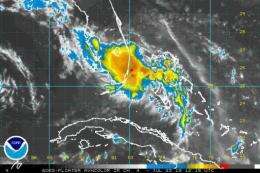This National Oceanic and Atmospheric Administration (NOAA) satellite image shows tropical storm Bonnie nearing southern Florida. Crews working on a huge oil spill evacuated Friday as the tropical storm barreled toward the Gulf of Mexico, prolonging the region's environmental and economic nightmare.
Crews working on a huge oil spill evacuated Friday as a tropical storm barreled toward the Gulf of Mexico, prolonging the region's environmental and economic nightmare.
The cap in place for a week on the ruptured well will remain in place, but efforts to complete relief wells for a permanent fix were set back by the evacuation as Tropical Storm Bonnie churned toward the area.
BP said in a statement Friday it suspended work on its relief well drilling in consultation with government officials "because of potentially adverse weather" associated with Bonnie.
At 1200 GMT, Bonnie was some 130 kilometers (80 miles) south-east of Miami, Florida, packing sustained winds of 65 kilometers (40 miles) per hour.
The storm was moving at a fast clip of 31 kilometers (19 miles) per hour toward the Florida Straits and the Gulf of Mexico, the National Weather Service said.
Tropical storm warnings were posted for much of the Florida coast and storm watches were posted for areas as far west as Morgan City, Louisiana.
Bonnie is expected to move over southern Florida on Friday, reaching the eastern Gulf of Mexico Saturday -- and arrive at Louisiana on Sunday.
Louisiana Governor Bobby Jindal issued an emergency declaration which will help speed state assistance to areas in need.
US spill response chief Admiral Thad Allen announced Thursday that the nearly 2,000 people responding to the BP oil spill at the well site would return to land "due to the risk that Tropical Storm Bonnie poses."
Allen has previously said evacuating crew could delay an operation to finally plug the runaway well by up to 12 days, but he said Thursday safety concerns would trump the desire for a speedy resolution.
"While these actions may delay the effort to kill the well for several days, the safety of the individuals at the well site is our highest concern," he said.
Allen decided the cap holding back the torrent of crude for the past week would stay on, providing some respite for those in the Gulf region struggling to cope with the huge economic impact of the disaster.
There had been fears the cap would have to be opened up or even removed because nobody would be on site to monitor any pressure anomalies in the well or oil seepage on the sea floor.
But Allen said he had ordered BP to make sure their remotely operated vehicles (ROVs), which do the crucial monitoring for oil leaks and other anomalies, are the last to leave when the storm arrives.
Work to concrete in the casing on the relief well will now be postponed until the giant drilling rig can return.
After the concrete sets, a process expected to take up to a week, officials hope to perform a "static kill" to plug the well by injecting heavy drilling mud and cement through the cap at the top.
The final operation to cement the reservoir through the relief well would be expected five to seven days after that.
The evacuation was a huge blow for locals who already see efforts to choke off the well as too little too late, with hundreds of miles of coastline already fouled.
The five US states along the Gulf of Mexico could lose 22.7 billion dollars in tourist revenue over the next three years because of the spill, a study showed.
A vast swath of the Gulf has also been closed to commercial and sport fishing since the BP-leased Deepwater Horizon rig sank on April 22, two days after an explosion that killed 11 workers.
But US officials reopened one third of those fishing grounds after no oil was seen in the area for 30 days and tests revealed the fish there were not contaminated.
Oil industry jobs have also been hit by President Barack Obama's decision to impose a moratorium on new deep-sea drilling.
If an upper estimate of over four million barrels is confirmed, the Gulf spill would be the biggest accidental oil spill ever.
(c) 2010 AFP























